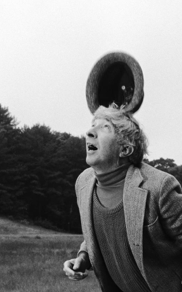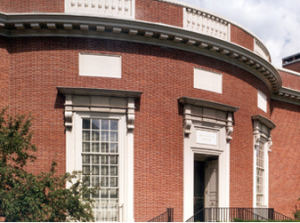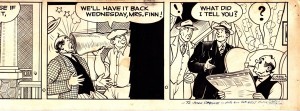Category Archives: Museums & Exhibitions
Michael Updike: Moran’s haul wasn’t trash
We received the following note and accompanying materials from Michael Updike, who notes that the bags that Paul Moran famously hauled away from his father’s Beverly Farms curbside contained much more than trash, and offers an important donation if Moran will donate his part to The John Updike Childhood House:
Dear John Updike Society,
As you know my father, as a young aspiring cartoonist, sent off fan letters asking established cartoonist for original artwork. I have enclosed a letter to Harold Gray of The Blondie strip that has miraculously survived.
The most famous successes to these letters were original works by Saul Stienberg and James Thurber. These were in the exhibit of JHU items at the Boston conference and mentioned in Due Consideration P.612 . Another bit of booty was this original Mickey Finn strip by Lank Leonard. It is signed in cartoon capitals “-TO JOHN UPDIKE-WITH ALL THE BEST FROM Lank Leonard”. It has been kicking around our house ever since I remember. At some point (circa mid seventies) the last three panels went missing. The tape had long given way. I assumed they were lost for good to the far corners of the house or thrown out. Recently, to my great surprise, the lost panels showed up on The Other John Updike Archive. I can only assume that my father took them during the divorce and they went to the trash shortly before or after his demise. My siblings and I would love to see the two parts of this comic reunited after forty years of separation. We would happily donate our half of the work to the John Updike House if the other owner would donate as well.
Thanks very Much
Michael
January 2, 1948
Mr. Harold Gray
c/o New York News Syndicate
220 East 42nd Street
New York 17, New York
Dear Mr. Gray:
I don’t suppose that I am being original when I admit that ORPHAN ANNIE is, and has been for a long time, my favorite comic strip. There are many millions like me. The appeal of your comic strip is an American phenomenon that has affected the public for many years, and will, I hope, continue to do so for many more.
I admire the magnificent plotting of Annie’s adventures. They are just as adventure strips should be–fast moving, slightly macabre (witness Mr. Am), occasionally humorous, and above all, they show a great deal of the viciousness of human nature. I am very fond of the gossip-in-the-street scenes you frequently use. Contrary to comic-strip tradition, the people are not pleasantly benign, but gossiping, sadistic, and stupid, which is just as it really is.
Your villains are completely black and Annie and crew are practically perfect, which is as it should be. To me there is nothing more annoying in a strip than to be in the dark as to who is the hero and who the villain. I like the methods in which you polish off your evil-doers. One of my happiest moments was spent in gloating over some hideous child (I forget his name) who had been annoying Annie toppled into the wet cement of a dam being constructed. I hate your villains to the point where I could rip them from the paper. No other strip arouses me so. For instance, I thought Mumbles was cute.
Your draughtsmanship is beyond reproach. The drawing is simple and clear, but extremely effective. You could tell just by looking at the faces who is the trouble maker and who isn’t, without any dialogue. The facial features, the big, blunt fingered hands, the way you handle light and shadows are all excellently done. Even the talk balloons are good, the lettering small and clean, the margins wide, and the connection between the speaker and his remark wiggles a little, all of which, to my eye, is as artistic as you can get.
All this well-deserved praise is leading up to something, of course, and the catch is a rather big favor I want you to do for me. I need a picture to alleviate the blankness of one of my bedroom walls, and there is nothing that I would like better than a little momento of the comic strip I have followed closely for over a decade. So–could you possibly send me a little autographed sketch of Annie that you have done yourself? I realize that you probably have some printed cards you send to people like me, but could you maybe do just a quick sketch by yourself? Nothing funny, just what you have done yourself. I you cannot do this (and I really wouldn’t blame you) will you send me anything you like, perhaps an original comic strip? Whatever I get will be appreciated, framed, and hung.
Sincerely,
(Signed, ‘John Updike’)
John Updike
Elverson P. D. #2
Moran did the Updike world a huge favor when he saved all those bags from the dumpster, and the Society would have loved to bid on them. They would have made for terrific exhibits for The John Updike Childhood Home at 117 Philadelphia Avenue in Shillington, Pa., where Updike said his “artistic eggs were hatched.” Hopefully they’ll end up in a public, not private, collection.
The John Updike Society is committed to building a world-class author home museum, and anyone with materials to donate or offer for sale should contact Society president James Plath, jplath@iwu.edu. We are a 501c3 non-profit organization so all donations are tax deductible, and all donors will be acknowledged at the point of exhibit. We are also planning a donor wall where all who donate $500 or more, cash or in-kind, will be honored.
Gallery includes fun Updike photo
 If you’re in the Boston area you might check out the John Goodman show, “HomeTown,” now on display at the Miller Yezerski Gallery through February 3.
If you’re in the Boston area you might check out the John Goodman show, “HomeTown,” now on display at the Miller Yezerski Gallery through February 3.
Fifty-three photographs are featured, including a portrait of Barrack Obama when he was still a Harvard Law student and a fun shot of John Updike balancing a sideways-turned hat on his head.
The gallery is located at 460 Harrison Ave. in Boston, and you can phone (617) 262-0550 for more information.
You can see the Obama and Updike photos in a Boston Globe story by Mark Feeney.
Updike materials exhibited at the Houghton Library through May 31
 The Houghton Library at Harvard University is the main repository for Updike materials, and through May 31 you can catch a glimpse of those materials in a ground floor exhibition (Chaucer Case). Here’s the description:
The Houghton Library at Harvard University is the main repository for Updike materials, and through May 31 you can catch a glimpse of those materials in a ground floor exhibition (Chaucer Case). Here’s the description:
John Updike was in many ways an ideal Harvard student. He worked diligently at his studies, as evidenced by the marginalia recorded in the books he used in class (he graduated summa cum laude in 1954); he was an active member of the Harvard Lampoon, and served as president (nearly two-thirds of each issue during his senior year are attributed to him); he also remained a loving son, regularly writing amusing letters home to his parents in Shillington, Pennsylvania. Although Updike originally envisioned a career as an artist, there is evidence of the emerging professional writer; as a student, Updike received high marks on work that he would later submit to The New Yorker and other publications.
Updike began depositing his papers at Houghton Library in 1966; the collection was purchased by the library following his death in 2009. Updike meticulously shepherded his work through every stage of its publication, and the collection includes multiple drafts, prints and proofs of his novels, short stories, poems and essays, correspondence with colleagues, family, and friends, and Updike’s own copies of his books as well as books by other authors from his library.
The exhibition will be on display May 27, 28, 30 and 31. Click here for library hours.
Updike at the National Portrait Gallery
 In January 2009, the National Portrait Gallery wrote about Updike and the Alex Katz portrait of him that’s on display in Washington, D.C. and posted it on their facetoface blog.
In January 2009, the National Portrait Gallery wrote about Updike and the Alex Katz portrait of him that’s on display in Washington, D.C. and posted it on their facetoface blog.
Readers will recognize the portrait as the one from the October 18, 1982 edition of Time magazine. It’s not exactly breaking news, but members headed for the American Literature Association conference in Washington, D.C. this May might be interested to read up on the painting before visiting the National Portrait Gallery.
And Updike fans who don’t know the story behind the cover might find it fascinating. Time donated the oil-on-canvas, which they had commissioned, to the Gallery. Look for it in the 20th Century Americans exhibition on the third floor. The blog post includes a reprint of an article that Frederick Voss, a former historian at the National Portrait Gallery, wrote about the Updike portrait for the museum’s Profile magazine (Spring 2003).
Here’s a link to the full facetoface blog post: “John Updike: March 18, 1932 – January 27, 2009.”



